Sustainable Consumption Behaviour in Colombia: An Exploratory Analysis
Abstract
1. Introduction
2. Literature Review
2.1. Conceptualising Sustainable Consumption Behaviour
2.1.1. Quality of Life
2.1.2. Environmental Care
2.1.3. Resources for Future Generations
3. Materials and Methods
4. Results
4.1. Cluster One: Moderate
4.2. Cluster Two: Sustainable
5. Discussion
6. Conclusions
Author Contributions
Funding
Institutional Review Board Statement
Informed Consent Statement
Data Availability Statement
Acknowledgments
Conflicts of Interest
References
- Dietz, T.; Rosa, E.A. Effects of population and affluence on CO2 emissions. Proc. Natl. Acad. Sci. USA 1997, 94, 175–179. [Google Scholar] [CrossRef]
- Dietz, T.; Rosa, E.A.; York, R. Driving the human ecological footprint. Front. Ecol. Environ. 2007, 5, 13–18. [Google Scholar] [CrossRef]
- Wang, C.; Ghadimi, P.; Lim, M.K.; Tseng, M.-L. A literature review of sustainable consumption and production: A comparative analysis in developed and developing economies. J. Clean. Prod. 2019, 206, 741–754. [Google Scholar] [CrossRef]
- IPCC. Climate Change 2014 Impacts, Adaptation, and Vulnerability; Field, C.B., Barros, V.R., Dokken, D.J., Mach, K.J., Mastrandrea, M.D., Eds.; Cambridge University Press: Cambridge, UK, 2014. [Google Scholar]
- Meadows, D.H.; Meadows, D.L.; Randers, J.; Behrens, W.W. The Limits to Growth: A Report for the Club of Rome’s Project on the Predicament of Mankind, 2nd ed.; Universe Books: New York, NY, USA, 1974. [Google Scholar]
- Quoquab, F.; Sukari, N.N. Why Sustainable Consumption Is Not in Practice? A Developing Country Perspective. In World Sustainability Series; Leal Filho, W., Pociovalisteanu, D.-M., Al-Amin, A.Q., Eds.; Springer Science and Business Media LLC: Cham, Switzerland, 2016; pp. 103–113. [Google Scholar]
- Seiffert, M.E.B.; Loch, C. Systemic thinking in environmental management: Support for sustainable development. J. Clean. Prod. 2005, 13, 1197–1202. [Google Scholar] [CrossRef]
- UNESCO. Education for Sustainable Development: Sourcebook; UNESCO: Paris, France, 2012. [Google Scholar]
- Akenji, L.; Bengtsson, M. Making Sustainable Consumption and Production the Core of Sustainable Development Goals. Sustainability 2014, 6, 513–529. [Google Scholar] [CrossRef]
- The Oslo Symposium. Defining Sustainable Consumption. Available online: https://enb.iisd.org/consume/oslo004.html (accessed on 18 November 2020).
- ONU. Objetivos de Desarrollo Sostenible. Organización de las Naciones Unidas. 2015. Available online: https://www.un.org/sustainabledevelopment/es/sustainable-consumption-production (accessed on 15 October 2020).
- Congreso de la República de Colombia. Ley 99 de 1993. Available online: http://www.secretariasenado.gov.co/senado/basedoc/ley_0099_1993.html (accessed on 18 November 2020).
- Ministerio del Medio Ambiente. Política Nacional de Producción y Consumo: Hacia una Cultura de Consumo Sostenible y Transformación Productive; Ministerio del Medio Ambiente: Bogotá, Colombia, 2010.
- Tangsupwattana, W.; Liu, X. Symbolic consumption and Generation Y consumers: Evidence from Thailand. Asia Pac. J. Mark. Logist. 2017, 29, 917–932. [Google Scholar] [CrossRef]
- OECD. Economic Commission for Latin America and the Caribbean. OECD Environmental Performance Reviews: Colombia 2014. OECD Environ. Perform. Rev. 2014. [Google Scholar] [CrossRef]
- Wolff, F.; Schönherr, N. The Impact Evaluation of Sustainable Consumption Policy Instruments. J. Consum. Policy 2011, 34, 43–66. [Google Scholar] [CrossRef]
- Quoquab, F.; Mohammad, J.; Sukari, N.N. A multiple-item scale for measuring “sustainable consumption behaviour” construct. Asia Pac. J. Mark. Logist. 2019, 31, 791–816. [Google Scholar] [CrossRef]
- Sandoval, M. Comportamiento Sustentable y Educación Ambiental: Una Visión Desde Las Prácticas Culturales. Rev. Latinoam. Psicol. 2012, 44, 181–196. [Google Scholar]
- Arias, B.N. El consumo responsable: Educar para la sostenibilidad ambiental. Aibi Rev. Investig. Adm. Ing. 2016, 4, 29–34. [Google Scholar] [CrossRef]
- Peralta-Miranda, P.; Cervantes-Atia, V.; Blanco-Ariza, A. Consumo sostenible de los servicios públicos en grupos familiares del estrato 1 en Barranquilla, Colombia. In Marketing y Competitividad en las Organizaciones: Enfoques y Perspectivas; Prieto, R., De la Hoz, R., Eds.; Ediciones Universidad Simón Bolívar: Barranqilla, Colombia, 2017. [Google Scholar]
- Cardona, J.M.; Riaño, D.M.; Vaca, Y.C. Marketing y consumidor green. Aplicación de la Matriz Mic Mac para el análisis de tendencias. Rev. Luciernaga Comun. 2017, 9, 12–23. [Google Scholar] [CrossRef]
- Antonides, G. Sustainable Consumer Behaviour: A Collection of Empirical Studies. Sustainability 2017, 9, 1686. [Google Scholar] [CrossRef]
- Trudel, R. Sustainable consumer behavior. Consum. Psychol. Rev. 2018. [Google Scholar] [CrossRef]
- Stern, P.C. New Environmental Theories: Toward a Coherent Theory of Environmentally Significant Behavior. J. Soc. Issues 2000, 56, 407–424. [Google Scholar] [CrossRef]
- Stern, P.C. Individual and household interactions with energy systems: Toward integrated understanding. Energy Res. Soc. Sci. 2014, 1, 41–48. [Google Scholar] [CrossRef]
- Bratt, C.; Stern, P.C.; Matthies, E.; Nenseth, V. Home, Car Use, and Vacation. Environ. Behav. 2014, 47, 436–473. [Google Scholar] [CrossRef]
- Midilli, A.; Dincer, I.; Ay, M. Green energy strategies for sustainable development. Energy Policy 2006, 34, 3623–3633. [Google Scholar] [CrossRef]
- Kinoti, M.W. Green Marketing Intervention Strategies and Sustainable Development: A Conceptual Paper. Int. J. Bus. Soc. Sci. 2011, 2, 263–273. [Google Scholar]
- Cavicchi, A. The New Rules of Green Marketing. Strategies, Tools, and Inspiration for Sustainable Branding20121Edited by Jacquelyn, A. Ottman. The New Rules of Green Marketing. Strategies, Tools, and Inspiration for Sustainable Branding. San Francisco, CA: Berrett-Koehler Publishers 2011. 252 pp. US $21.95. J. Consum. Mark. 2012, 29, 310–311. [Google Scholar] [CrossRef]
- Henseler, J. Bridging Design and Behavioral Research with Variance-Based Structural Equation Modeling. J. Advert. 2017, 46, 178–192. [Google Scholar] [CrossRef]
- Sun, M.; Trudel, R. The Effect of Recycling versus Trashing on Consumption: Theory and Experimental Evidence. J. Mark. Res. 2017, 54, 293–305. [Google Scholar] [CrossRef]
- Trudel, R.; Argo, J.J.; Meng, M.D. The Recycled Self: Consumers’ Disposal Decisions of Identity-Linked Products. J. Consum. Res. 2016, 43, 246–264. [Google Scholar] [CrossRef]
- Torres, R.M.S. Desigualdad del ingreso en Colombia: Un estudio por departamentos. Cuad. Econ. 2017, 36, 139–178. [Google Scholar] [CrossRef]
- Ryan, R.M.; Deci, E.L. Self-determination theory and the facilitation of intrinsic motivation, social development, and well-being. Am. Psychol. 2000, 55, 68–78. [Google Scholar] [CrossRef] [PubMed]
- Kasser, T. Living both well and sustainably: A review of the literature, with some reflections on future research, interventions and policy. Philos. Trans. R. Soc. A Math. Phys. Eng. Sci. 2017, 375, 20160369. [Google Scholar] [CrossRef]
- Hirvilammi, T.; Laakso, S.; Lettenmeier, M.; Lähteenoja, S. Studying Well-being and its Environmental Impacts: A Case Study of Minimum Income Receivers in Finland. J. Hum. Dev. Capab. 2013, 14, 134–154. [Google Scholar] [CrossRef]
- Max-Neef, M.A.; Elizalde, A.; Hopenhayn, M. Human Scale Development: Conception, Application and Further Reflections; The Apex Press: New York, NY, USA, 1991. [Google Scholar]
- Blaitt, R. La estructura social de la comunidad y su aporte en la búsqueda de sostenibilidad: El caso de las ecoaldeas. Cuad. Investig. Urban. 2010, 69, 14–32. [Google Scholar]
- Corral-Verdugo, V.; Mireles-Acosta, J.F.; Tapia-Fonllem, C.; Fraijo-Sing, B. Happiness as Correlate of Sustainable Behavior: A Study of Pro-Ecological, Frugal, Equitable and Altruistic Actions That Promote Subjective Wellbeing. Hum. Ecol. Rev. 2011, 18, 95–104. [Google Scholar]
- Welsch, H.; Kühling, J. Are pro-environmental consumption choices utility-maximizing? Evidence from subjective well-being data. Ecol. Econ. 2011, 72, 75–87. [Google Scholar] [CrossRef]
- Verhofstadt, E.; Van Ootegem, L.; Defloor, B.; Bleys, B. Linking individuals’ ecological footprint to their subjective well-being. Ecol. Econ. 2016, 127, 80–89. [Google Scholar] [CrossRef]
- Nguyen, N.; Nguyen, H.V.; Lobo, A.; Dao, S.T. Encouraging Vietnamese Household Recycling Behavior: Insights and Implications. Sustainability 2017, 9, 179. [Google Scholar] [CrossRef]
- Castellacci, F.; Tveito, V. Internet use and well-being: A survey and a theoretical framework. Res. Policy 2018, 47, 308–325. [Google Scholar] [CrossRef]
- Guillen-Royo, M. Sustainable consumption and wellbeing: Does on-line shopping matter? J. Clean. Prod. 2019, 229, 1112–1124. [Google Scholar] [CrossRef]
- Arvola, A.; Vassallo, M.; Dean, M.; Lampila, P.; Saba, A.; Lähteenmäki, L.; Shepherd, R. Predicting intentions to purchase organic food: The role of affective and moral attitudes in the Theory of Planned Behaviour. Appetite 2008, 50, 443–454. [Google Scholar] [CrossRef]
- Liu, X.; Wang, C.; Shishime, T.; Fujitsuka, T. Sustainable consumption: Green purchasing behaviours of urban residents in China. Sustain. Dev. 2012, 20, 293–308. [Google Scholar] [CrossRef]
- Nguyen, N.; Phan, T.T.H.; Cao, T.K.; Nguyen, H.V. Green purchase behavior: Mitigating barriers in developing countries. Strat. Dir. 2017, 33, 4–6. [Google Scholar] [CrossRef]
- Padel, S.; Foster, C. Exploring the gap between attitudes and behaviour. Br. Food J. 2005, 107, 606–625. [Google Scholar] [CrossRef]
- Agrawal, A.K.; Rahman, Z. Roles and Resource Contributions of Customers in Value Co-creation. Int. Strat. Manag. Rev. 2015, 3, 144–160. [Google Scholar] [CrossRef]
- Young, W.; Hwang, K.; McDonald, S.; Oates, C.J. Sustainable consumption: Green consumer behaviour when purchasing products. Sustain. Dev. 2010, 18, 20–31. [Google Scholar] [CrossRef]
- Banytė, J.; Šalčiuvienė, L.; Dovalienė, A.; Piligrimienė, Ž.; Sroka, W. Sustainable Consumption Behavior at Home and in the Workplace: Avenues for Innovative Solutions. Sustainability 2020, 12, 6564. [Google Scholar] [CrossRef]
- Aertsens, J.; Mondelaers, K.; Verbeke, W.; Buysse, J.; Van Huylenbroeck, G. The influence of subjective and objective knowledge on attitude, motivations and consumption of organic food. Br. Food J. 2011, 113, 1353–1378. [Google Scholar] [CrossRef]
- Tanner, C.; Kast, S.W. Promoting sustainable consumption: Determinants of green purchases by Swiss consumers. Psychol. Mark. 2003, 20, 883–902. [Google Scholar] [CrossRef]
- Vermeir, I.; Verbeke, W. Sustainable Food Consumption: Exploring the Consumer “Attitude-Behavioral Intention” Gap. J. Agric. Environ. Ethics 2006, 19, 169–194. [Google Scholar] [CrossRef]
- Joshi, Y.; Rahman, Z. Factors Affecting Green Purchase Behaviour and Future Research Directions. Int. Strat. Manag. Rev. 2015, 3, 128–143. [Google Scholar] [CrossRef]
- Mainieri, T.; Barnett, E.G.; Valdero, T.R.; Unipan, J.B.; Oskamp, S. Green Buying: The Influence of Environmental Concern on Consumer Behavior. J. Soc. Psychol. 1997, 137, 189–204. [Google Scholar] [CrossRef]
- Hughner, R.S.; McDonagh, P.; Prothero, A.; Shultz, C.J.; Stanton, J. Who are organic food consumers? A compilation and review of why people purchase organic food. J. Consum. Behav. 2007, 6, 94–110. [Google Scholar] [CrossRef]
- Nguyen, N.; Lobo, A.; Greenland, S. Energy efficient household appliances in emerging markets: The influence of consumers’ values and knowledge on their attitudes and purchase behaviour. Int. J. Consum. Stud. 2016, 41, 167–177. [Google Scholar] [CrossRef]
- Tsakiridou, E.; Boutsouki, C.; Zotos, Y.; Mattas, K. Attitudes and behaviour towards organic products: An exploratory study. Int. J. Retail. Distrib. Manag. 2008, 36, 158–175. [Google Scholar] [CrossRef]
- Surya, B.; Syafri, S.; Sahban, H.; Sakti, H.H. Natural Resource Conservation Based on Community Economic Empowerment: Perspectives on Watershed Management and Slum Settlements in Makassar City, South Sulawesi, Indonesia. Land 2020, 9, 104. [Google Scholar] [CrossRef]
- Bilgen, S.; Sarıkaya, I. Energy conservation policy and environment for a clean and sustainable energy future. Energy Sources Part B Econ. Plan. Policy 2018, 13, 183–189. [Google Scholar] [CrossRef]
- Bulut, Z.A.; Çımrin, F.K.; Doğan, O. Gender, generation and sustainable consumption: Exploring the behaviour of consumers from Izmir, Turkey. Int. J. Consum. Stud. 2017, 41, 597–604. [Google Scholar] [CrossRef]
- Heo, J.; Muralidharan, S. What triggers young Millennials to purchase eco-friendly products? The interrelationships among knowledge, perceived consumer effectiveness, and environmental concern. J. Mark. Commun. 2017, 25, 421–437. [Google Scholar] [CrossRef]
- Hwang, J.; Griffiths, M.A. Share more, drive less: Millennials value perception and behavioral intent in using collaborative consumption services. J. Consum. Mark. 2017, 34, 132–146. [Google Scholar] [CrossRef]
- O’Rourke, D.; Lollo, N. Transforming Consumption: From Decoupling, to Behavior Change, to System Changes for Sustainable Consumption. Annu. Rev. Environ. Resour. 2015, 40, 233–259. [Google Scholar] [CrossRef]
- Patton, M.Q. Qualitative Research & Evaluation Methods: Integrating Theory and Practice, 4th ed.; SAGE Publications, Inc.: Thousand Oaks, CA, USA, 2015. [Google Scholar]
- Etikan, I. Sampling and Sampling Methods. Biom. Biostat. Int. J. 2017, 5, 1–3. [Google Scholar] [CrossRef]
- Cronbach, L.J. Coefficient alpha and the internal structure of tests. Psychometrika 1951, 16, 297–334. [Google Scholar] [CrossRef]
- Boateng, G.O.; Neilands, T.B.; Frongillo, E.A.; Melgar-Quiñonez, H.R.; Young, S.L. Best Practices for Developing and Validating Scales for Health, Social, and Behavioral Research: A Primer. Front. Public Health 2018, 6, 149. [Google Scholar] [CrossRef]
- Comrey, A.L.; Lee, H. A First Cours in Factor Analysis; Lawrence Erlbaum Associates, Inc.: Hillsdale, NJ, USA, 1992. [Google Scholar]
- Tan, P.-N.; Steinbach, M.; Karpatne, A.; Kumar, V. Introduction to Data Mining, 2nd ed.; Pearson: New York, NY, USA, 2019. [Google Scholar]
- Cohen, J. Statistical Power Analysis for the Behavioral Sciences, 2nd ed.; Routledge: New York, NY, USA, 1988. [Google Scholar]
- Ajzen, I.; Fishbein, M. Understanding Attitudes and Predicting Social Behavior; Prentice-Hall: Englewood Cliffs, NJ, USA, 1980. [Google Scholar]
- Simmons, D.; Widmar, R. Motivations and Barriers to Recycling: Toward a Strategy for Public Education. J. Environ. Educ. 1990, 22, 13–18. [Google Scholar] [CrossRef]
- Kang, J.; Liu, C.; Kim, S.-H. Environmentally sustainable textile and apparel consumption: The role of consumer knowledge, perceived consumer effectiveness and perceived personal relevance. Int. J. Consum. Stud. 2013, 37, 442–452. [Google Scholar] [CrossRef]
- Chan, T.S. Concerns for Environmental Issues and Consumer Purchase Preferences. J. Int. Consum. Mark. 1996, 9, 43–55. [Google Scholar] [CrossRef]
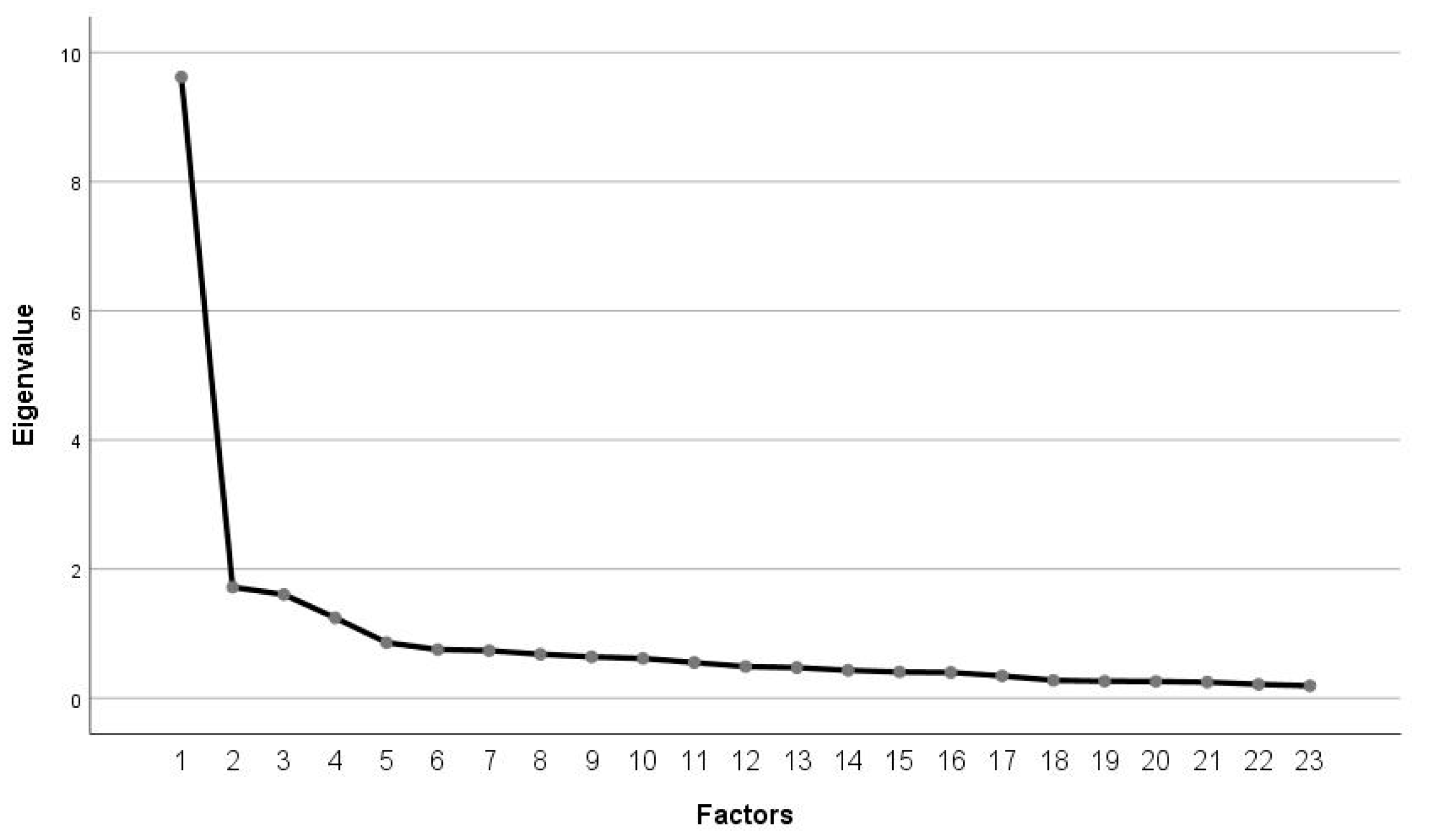
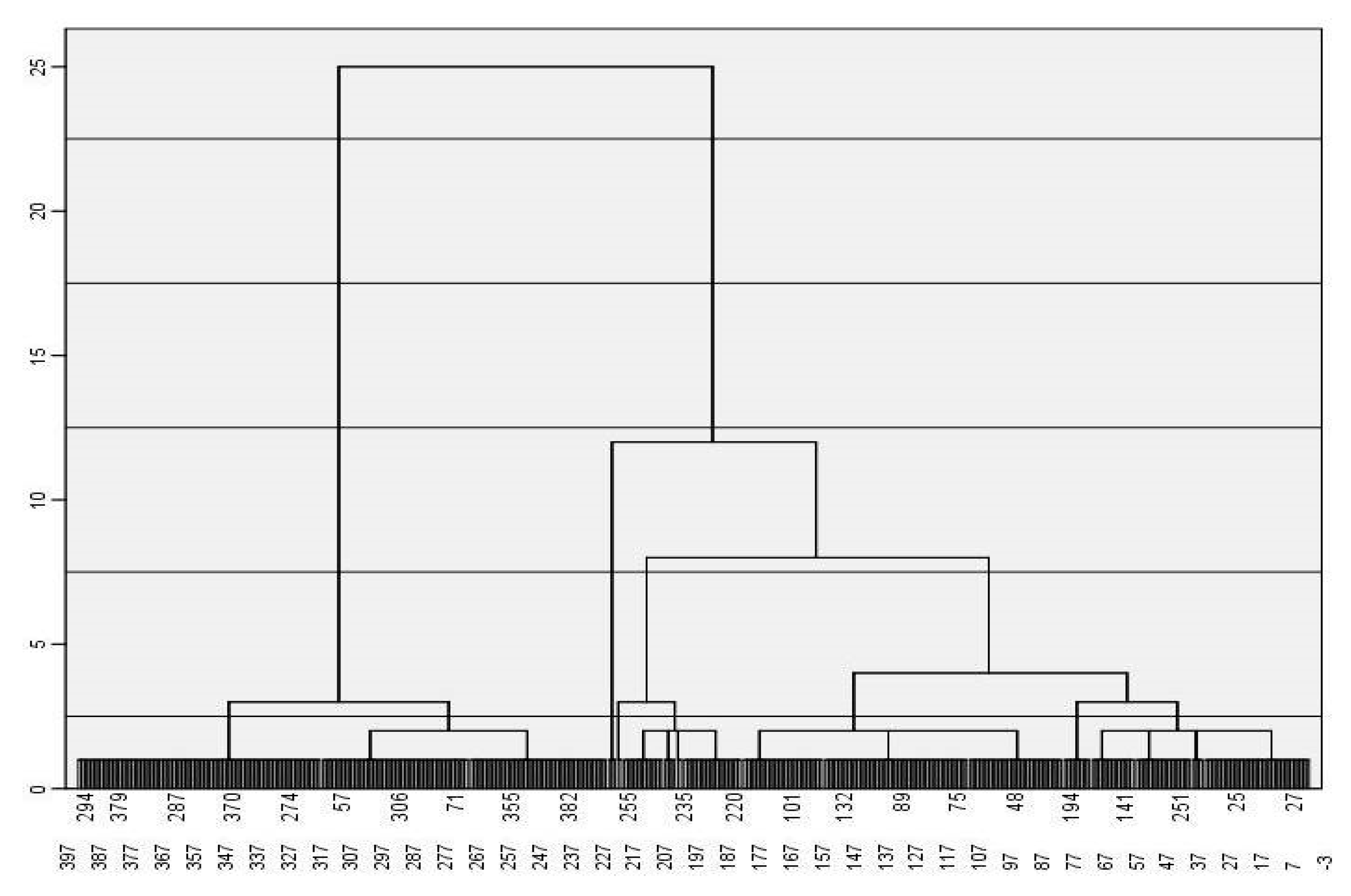
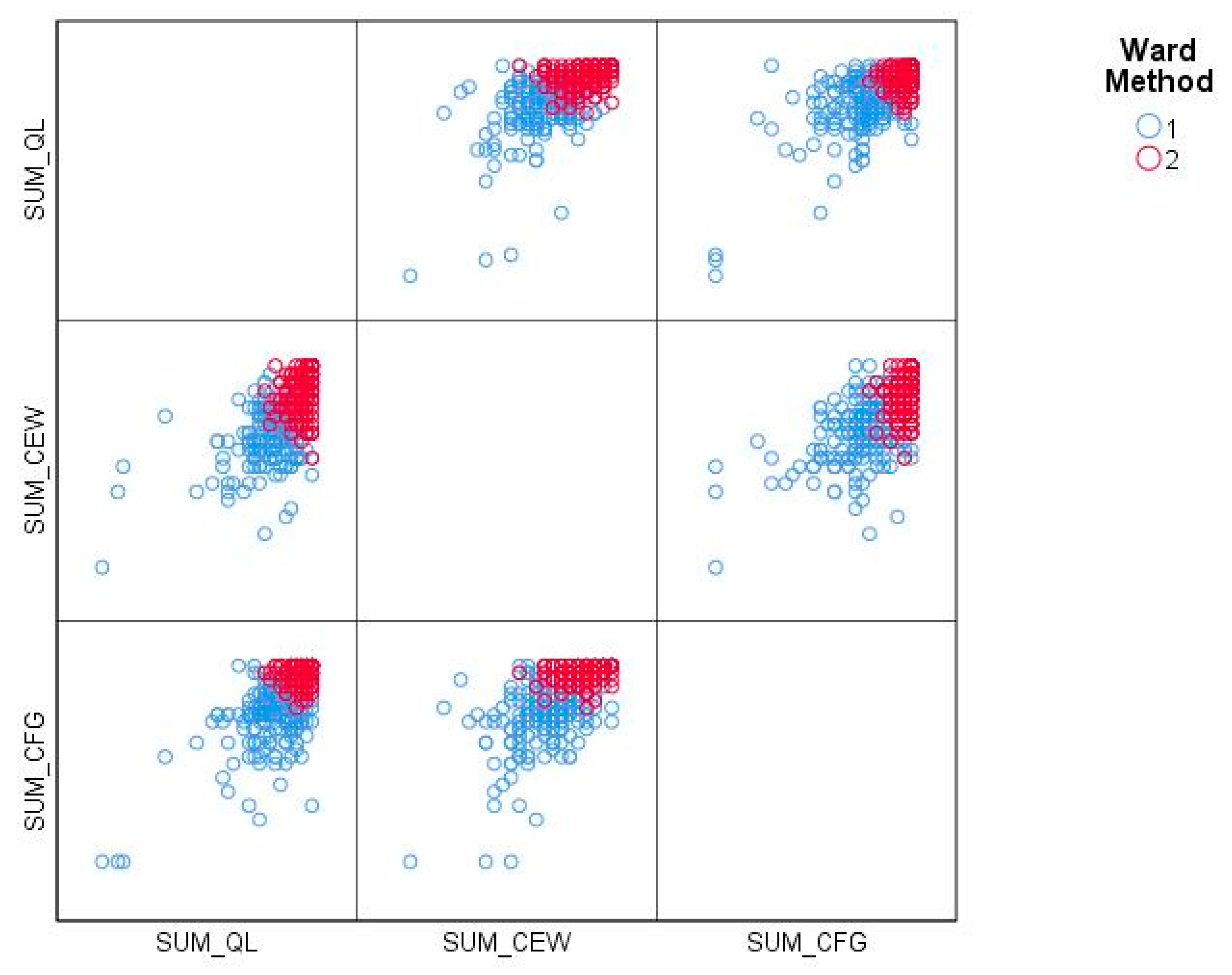
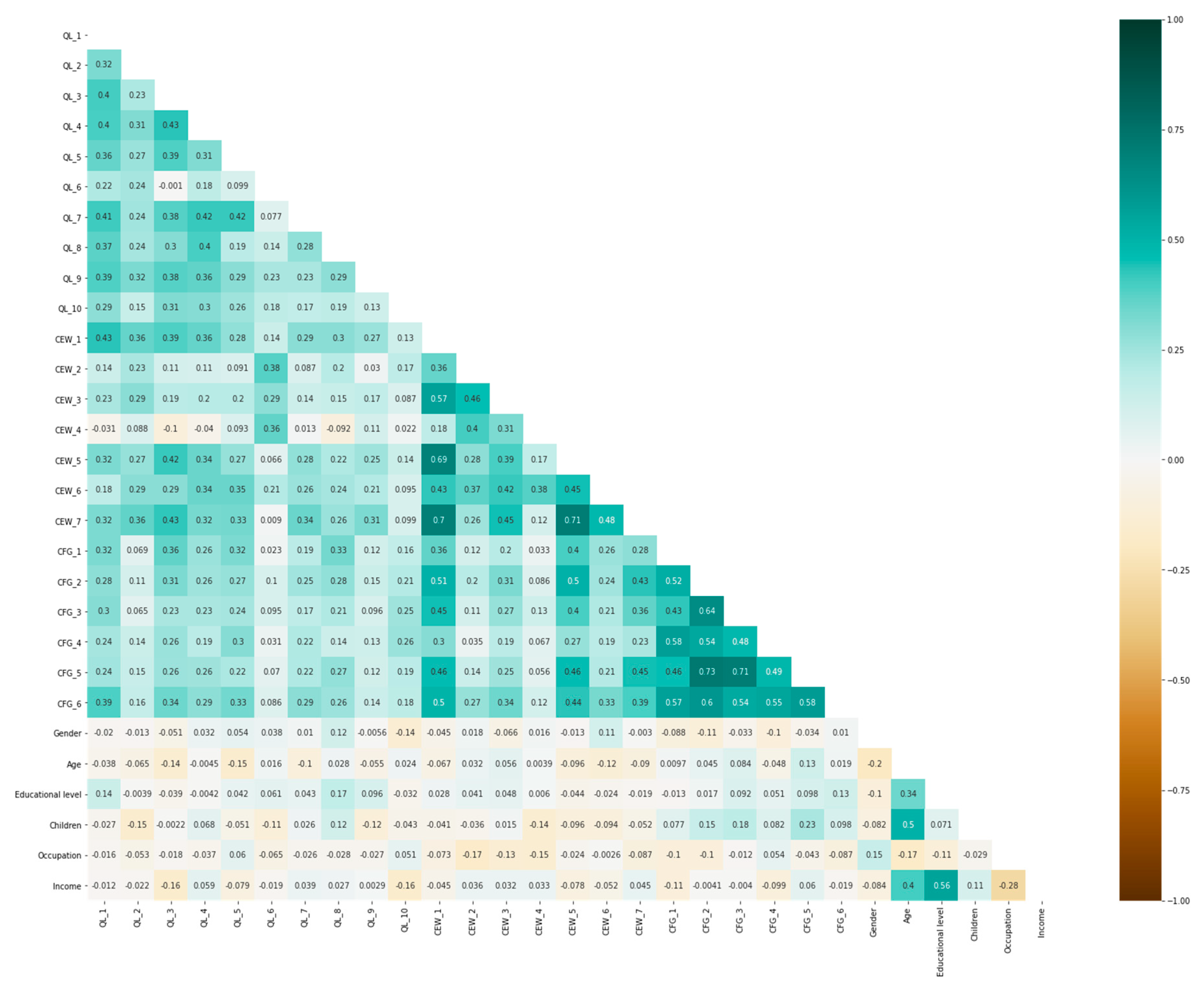
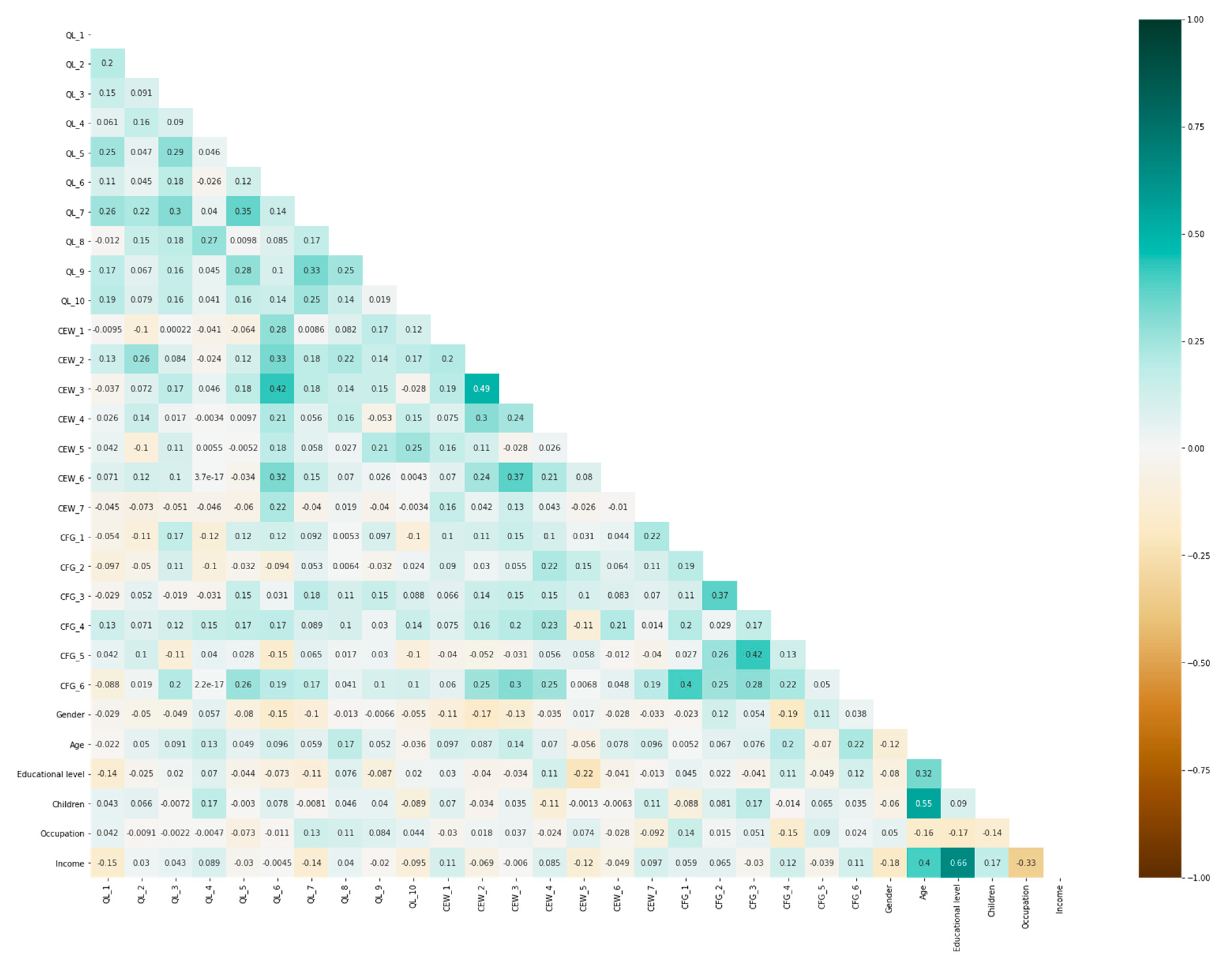
| Conceptualization | Behaviour | Example 1 |
|---|---|---|
| Quality of life refers to habits that aim to eliminate excessive purchases and the excessive use of goods and services without affecting the satisfaction of the consumer’s basic needs. | Reduce product consumption and waste. | Food, drinks, water, electricity, etc. |
| Recycle products. | Cardboard, paper, cans, etc. | |
| Reuse products. | Give clothes to charity, give second use to glass jars, etc. | |
| Buy products with biodegradable packaging. | straws, plates, bags, etc. | |
| Plan your purchases. | Market, vehicles, clothes, etc. | |
| Care for the environment refers to the habits of buying, using, and disposing of products that protect ecosystems. | Use ecological products. | Organic food, soaps, etc. |
| Use biodegradable materials. | Bags, spoons, papers etc. | |
| Concern for the environment. | Product impact analysis. | |
| Pay extra resources for ecological products. | Buy products with green or eco-friendly stamps. | |
| Resources for future generations represent the habits of consumers to avoid consuming too many resources that may be unavailable in the future. | Concern about the consumption of natural resources. | Save water, eliminate paper consumption, etc. |
| Guarantee the availability of natural resources. | Minerals, water, fish, etc. | |
| Control impulse purchases. | Budget planning, market lists, etc. |
| Characteristics | Results |
|---|---|
| Gender | Males: 186. Females: 207. |
| Age: | 18–25 years: 15%. 26–34 years: 33.6%. 35–49 years: 42.5%. 50–59 years: 8.1%. Over 60 years: 0.8%. |
| Educational level: | Undergraduates: 6.4%. Bachelor’s degree: 37.2%. Professional and Advanced Degree: 35.4%. Master: 10.9%. PhDs: 0.2%. |
| Number of children: | No children: 39.4%. 1: 26.5%. 2: 22.9%. 3 or more: 11.2%. |
| Occupation: | Self-employed: 19.8%. Employed: 59.3%. Student: 13.5%. Retired: 5%. In charge of housework: 1.5%. |
| Code 1 | Item | Behaviour |
|---|---|---|
| QL1 | I always try hard to reduce miss-use of goods and services (e.g., I switch off light and fan when I am not in the room). | Reduce consumption. |
| QL2 | I recycle daily newspaper (e.g., use as pet’s litter box, etc.). | Reuse products. |
| QL3 | I avoid overuse/consumption of goods and services (e.g., take print). only when needed) | Reduce consumption. |
| QL4 | I reuse paper to write on the other side. | Reuse products. |
| QL5 | While dining in restaurant, I order food(s) only the amount that I can eat in order to avoid wasting food. | Avoid product waste. |
| QL6 | I choose to buy product(s) with biodegradable container or Packaging. | Buy products with biodegradable packaging |
| QL7 | I don’t like to waste food or beverage. | Avoid product waste. |
| QL8 | I recycle my old stuff in every possible way (e.g., distribute old clothes among needy people. | Reuse products. |
| QL9 | I reuse shopping bag(s) every time go for shopping. | Reuse products. |
| QL10 | I plan carefully before I purchase a product of service. | Planning purchases. |
| CEW1 | I do care for the natural environment. | Care for the environment. |
| CEW2 | I use eco-friendly products and services. | Use ecological products |
| CEW3 | I purchase and use products which are environmentally friendly. | Use ecological products |
| CEW4 | I often pay extra money to purchase environmentally friendly product (e.g., organic food). | Pay extra money to buy organic products |
| CEW5 | I am concerned about the shortage of natural resources. | Care for the environment. |
| CEW6 | I prefer to use paper bag(s) since it is biodegradable. | Use biodegradable materials |
| CEW7 | I love our planet. | Care for the environment. |
| CFG1 | I always remember that my excess consumption can create hindrance for the future generation to meet up their basic needs. | Care about future generations. |
| CFG2 | I care for the need fulfilment of the next generation. | Concern about the consumption of natural resources. |
| CFG3 | I often think about future generations’ quality of life. | Care about future generations. |
| CFG4 | I try to control my desire for excessive purchase for the sake of future generation. | Guarantee the availability of natural resources. |
| CFG5 | I am concerned about the future generation. | Care about future generations. |
| CFG6 | I try to minimise the excess consumption for the sake of preserving environmental resources for future generations. | Care about the consumption of natural resources. |
| Code | Anti-Image Correlation | Code | Anti-Image Correlation |
|---|---|---|---|
| QL1 | 0.95 | CEW3 | 0.94 |
| QL2 | 0.94 | CEW4 | 0.90 |
| QL3 | 0.94 | CEW5 | 0.93 |
| QL4 | 0.94 | CEW6 | 0.95 |
| QL5 | 0.95 | CEW7 | 0.91 |
| QL6 | 0.92 | CFG1 | 0.93 |
| QL7 | 0.94 | CFG2 | 0.95 |
| QL8 | 0.93 | CFG3 | 0.94 |
| QL9 | 0.92 | CFG4 | 0.94 |
| QL10 | 0.90 | CFG5 | 0.92 |
| CEW1 | 0.95 | CFG6 | 0.96 |
| CEW2 | 0.91 |
| Item | Factors | ||
|---|---|---|---|
| 1 | 2 | 3 | |
| QL1 | 0.62 | ||
| QL2 | 0.47 | ||
| QL3 | 0.65 | ||
| QL4 | 0.62 | ||
| QL5 | 0.53 | ||
| QL6 | 0.60 | ||
| QL7 | 0.59 | ||
| QL8 | 0.46 | ||
| QL9 | 0.57 | ||
| QL10 | 0.34 | ||
| CEW1 | 0.45 | ||
| CEW2 | 0.72 | ||
| CEW3 | 0.65 | ||
| CEW4 | 0.64 | ||
| CEW5 | 0.47 | ||
| CEW6 | 0.52 | ||
| CEW7 | 0.50 | ||
| CFG1 | 0.66 | ||
| CFG2 | 0.80 | ||
| CFG3 | 0.77 | ||
| CFG4 | 0.64 | ||
| CFG5 | 0.80 | ||
| CFG6 | 0.69 | ||
| Item | Sum of Squares | Gl 1 | Quadratic Average | F 2 | p-Value |
|---|---|---|---|---|---|
| QL1 | 20.95 | 1 | 20.95 | 50.47 | 0.00 |
| QL2 | 70.41 | 1 | 70.41 | 69.93 | 0.00 |
| QL3 | 29.28 | 1 | 29.28 | 60.27 | 0.00 |
| QL4 | 25.62 | 1 | 25.62 | 51.77 | 0.00 |
| QL5 | 40.49 | 1 | 40.49 | 64.65 | 0.00 |
| QL6 | 81.25 | 1 | 81.25 | 118.72 | 0.00 |
| QL7 | 20.14 | 1 | 20.14 | 35.73 | 0.00 |
| QL8 | 24.51 | 1 | 24.51 | 47.68 | 0.00 |
| QL9 | 27.25 | 1 | 27.25 | 48.47 | 0.00 |
| QL10 | 36.45 | 1 | 36.45 | 61.93 | 0.00 |
| CEW1 | 32.86 | 1 | 32.86 | 77.95 | 0.00 |
| CEW2 | 73.96 | 1 | 73.96 | 144.17 | 0.00 |
| CEW3 | 67.05 | 1 | 67.05 | 133.99 | 0.00 |
| CEW4 | 71.80 | 1 | 71.80 | 78.89 | 0.00 |
| CEW5 | 30.50 | 1 | 30.50 | 76.63 | 0.00 |
| CEW6 | 52.80 | 1 | 52.80 | 76.32 | 0.00 |
| CEW7 | 15.21 | 1 | 15.21 | 45.99 | 0.00 |
| CFG1 | 112.25 | 1 | 112.25 | 268.27 | 0.00 |
| CFG2 | 62.28 | 1 | 62.28 | 144.01 | 0.00 |
| CFG3 | 86.17 | 1 | 86.17 | 175.17 | 0.00 |
| CFG4 | 94.08 | 1 | 94.08 | 188.88 | 0.00 |
| CFG5 | 55.77 | 1 | 55.77 | 143.11 | 0.00 |
| CFG6 | 90.01 | 1 | 90.01 | 238.22 | 0.00 |
Publisher’s Note: MDPI stays neutral with regard to jurisdictional claims in published maps and institutional affiliations. |
© 2021 by the authors. Licensee MDPI, Basel, Switzerland. This article is an open access article distributed under the terms and conditions of the Creative Commons Attribution (CC BY) license (http://creativecommons.org/licenses/by/4.0/).
Share and Cite
Guzmán Rincón, A.; Carrillo Barbosa, R.L.; Martín-Caro Álamo, E.; Rodríguez-Cánovas, B. Sustainable Consumption Behaviour in Colombia: An Exploratory Analysis. Sustainability 2021, 13, 802. https://doi.org/10.3390/su13020802
Guzmán Rincón A, Carrillo Barbosa RL, Martín-Caro Álamo E, Rodríguez-Cánovas B. Sustainable Consumption Behaviour in Colombia: An Exploratory Analysis. Sustainability. 2021; 13(2):802. https://doi.org/10.3390/su13020802
Chicago/Turabian StyleGuzmán Rincón, Alfredo, Ruby Lorena Carrillo Barbosa, Ester Martín-Caro Álamo, and Belén Rodríguez-Cánovas. 2021. "Sustainable Consumption Behaviour in Colombia: An Exploratory Analysis" Sustainability 13, no. 2: 802. https://doi.org/10.3390/su13020802
APA StyleGuzmán Rincón, A., Carrillo Barbosa, R. L., Martín-Caro Álamo, E., & Rodríguez-Cánovas, B. (2021). Sustainable Consumption Behaviour in Colombia: An Exploratory Analysis. Sustainability, 13(2), 802. https://doi.org/10.3390/su13020802





